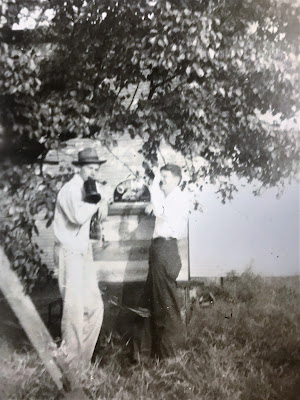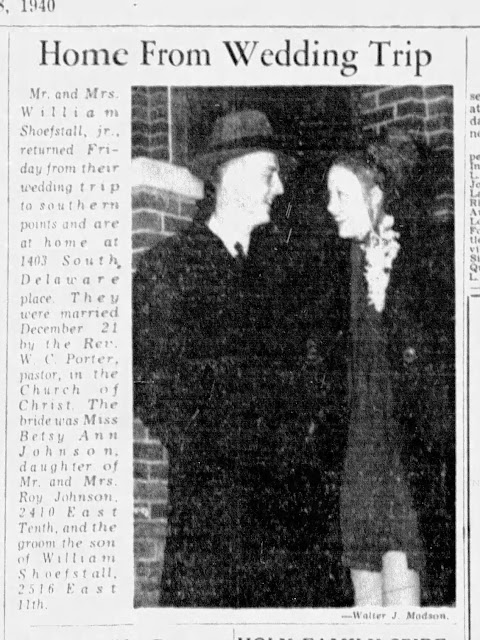The Shoefstall family was one of the first families to settle along Eleventh Street in what is now the Renaissance Neighborhood. They lived just east of the corner
of Eleventh Street and Lewis Avenue at 2516 E. Eleventh Street. (About where O’Reilly Auto Parts sits
today.)
According to those that knew him, Mr. William "Bill" Shoefstall was a very fine person. He and his wife, Beulah, had four children, Bill Jr., Eddie, Anna Mae and Alice. Mr. Shoefstall worked as machinist. When his two boys were old enough, they contributed to the family income. Bill Jr. worked as a shipping clerk and Eddie as a grocery clerk.
 |
| Alice Shoefstall |
 |
| Anna Mae Shoefstall |
Mr. Shoefstall spent evenings, with a few other neighborhood men, hauling and shoveling gravel by hand to build the alley that ran behind his home. Unless you have lived in a big city, crowded with buildings and homes, you may not fully appreciate the utility of an alley. Back alley ways allow for deliveries, parking and trash removal to take place without disrupting the harmony of the front entrance. The alley Mr. Shoefstall built is still there today.
 |
| The Eleventh Street Alley (Picture by H. Morgan) |
One story about Eddie has survived the years. Eddie and his buddies tried to make wine out of blackberries. Not quite knowing how to go about it, they improvised, capped off the bottles and stowed them under John Holderman's house, which was just a few houses east on 11th. As the homemade 'wine' fermented under the house, the pressure in the bottles built up. Then, in the middle of the night... the bottles began exploding one by one, waking up the Holderman household. It took Mr. Holderman a short while to figure out exactly what was going on.....luckily, no one go hurt.
 |
| Eddie Shoefstall (left) and James Holderman (right) - clowning around. |
Back in the 1930's and 40's, the stretch of Eleventh Street that ran west from Peoria to the traffic circle (parallel to Oaklawn Cemetery) was where cars and motorcycles went to race. Lots of folks would gather to spectate. The goal was to hit 100 miles per hour by the time they reached the viaduct. We can only imagine the thrill the spectacle must have been. Note: The traffic circle, visible below was built in 2012. In years gone by 11th split into a Y veering north to Elgin and continuing west as 11th Street.
On one fateful August day, Eddie borrowed a motorcycle from one of the Holderman boys, Charles aka "Chick", for a race. As he reached the viaduct, he hadn’t hit 100
mph so
he stayed with it until the did. He attempted to take the curve to the north onto Elgin. However, Eddie was going too fast and lost control, hitting the drug store. Eddie was killed on August 20th, 1942.
Due to the tragedy of the loss, one might have thought there’d have been lawsuits over the death, the motorcycle, this, that and the other. But it was a different time. There was never anything said
from either family.
Bill Jr. married and had a family of his own, settling down in a home at Fourteenth and Delaware Place.
Anna Mae lived to be 90 years old. She passed away on Christmas Eve of 2018.
 |
| Alice Shoefstall as a bridesmaid in the wedding of Harry P. "Boots" and Betty Marlowe, Holy Family Cathedral, November 11, 1943. |
One final but important connection of the Shoefstalls to our Renaissance Neighborhood- Our current neighborhood association president, P. Casey Morgan, is related to the Shoefstalls. Her grandmother, Willie, was Beulah's sister. Casey knew Anna Mae and confirms that the Shoefstalls were very fine people.
Holderman, J. (2019, October 5).
Personal interview. Also present were C.
Holderman and P. Casey Morgan.




Thank you, Arena. This is a fine tribute to the Shoefstall family.
ReplyDeleteThanks for sharing this story!
ReplyDelete